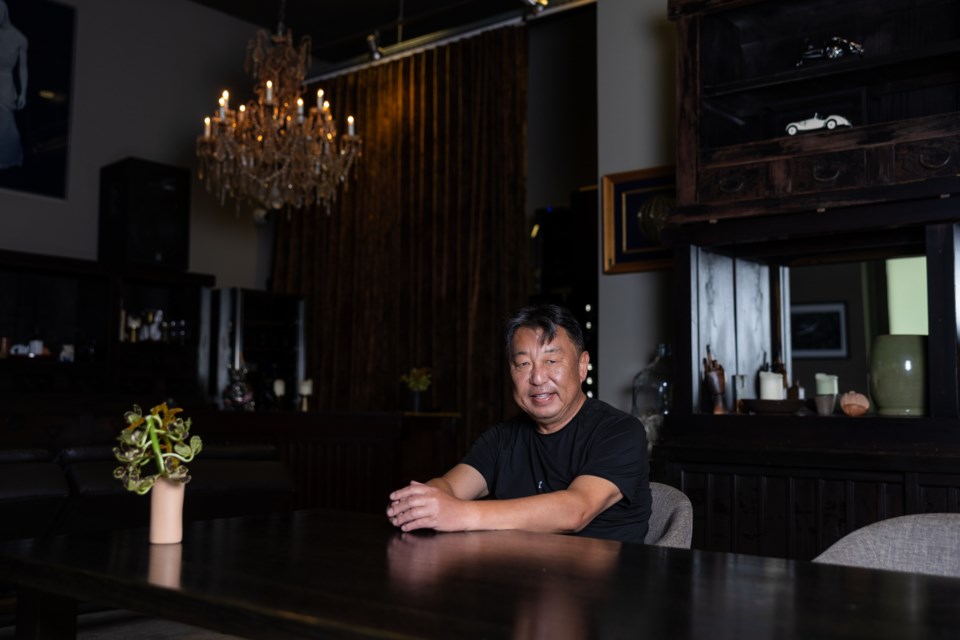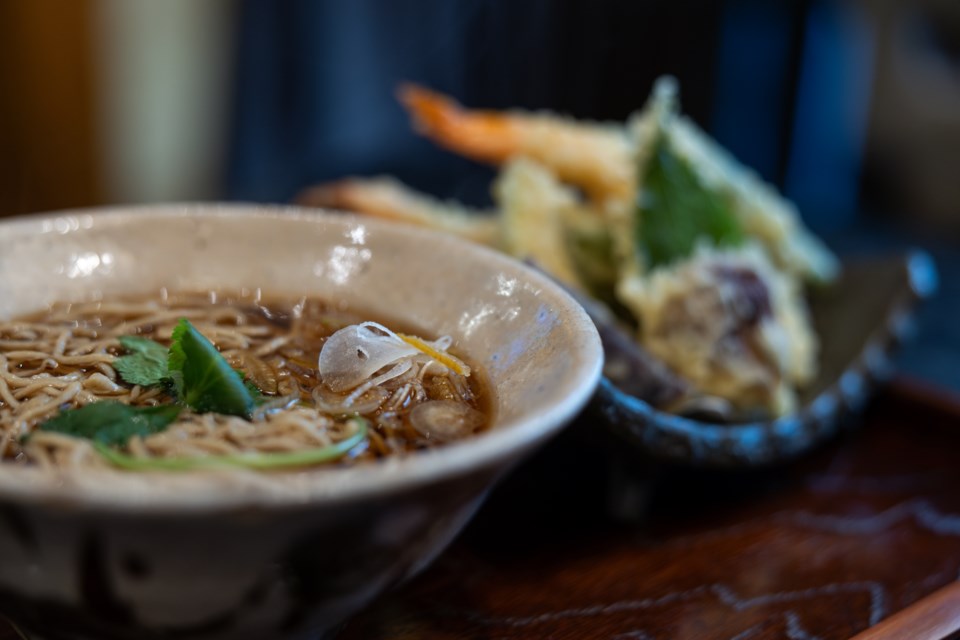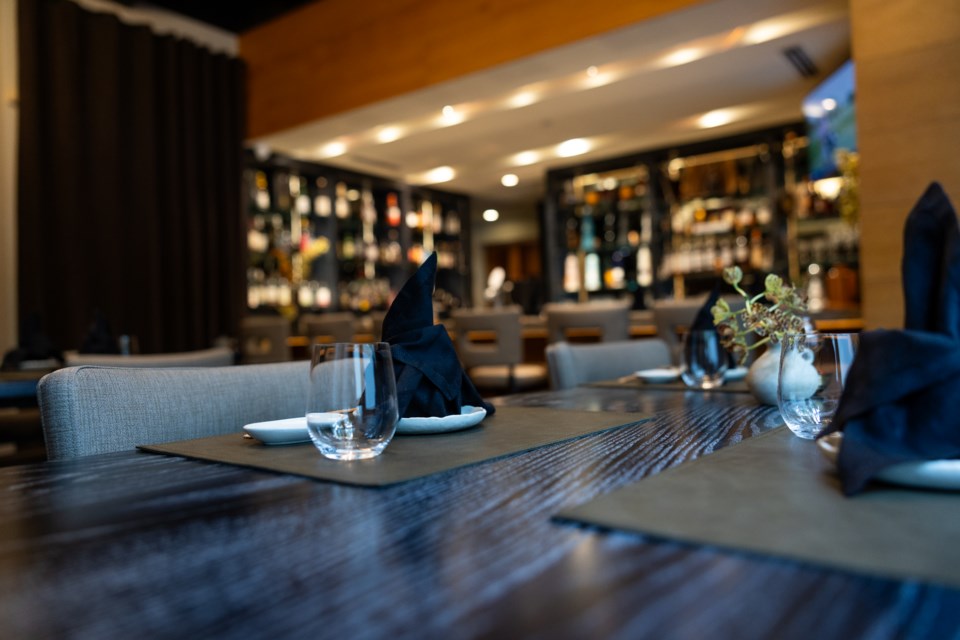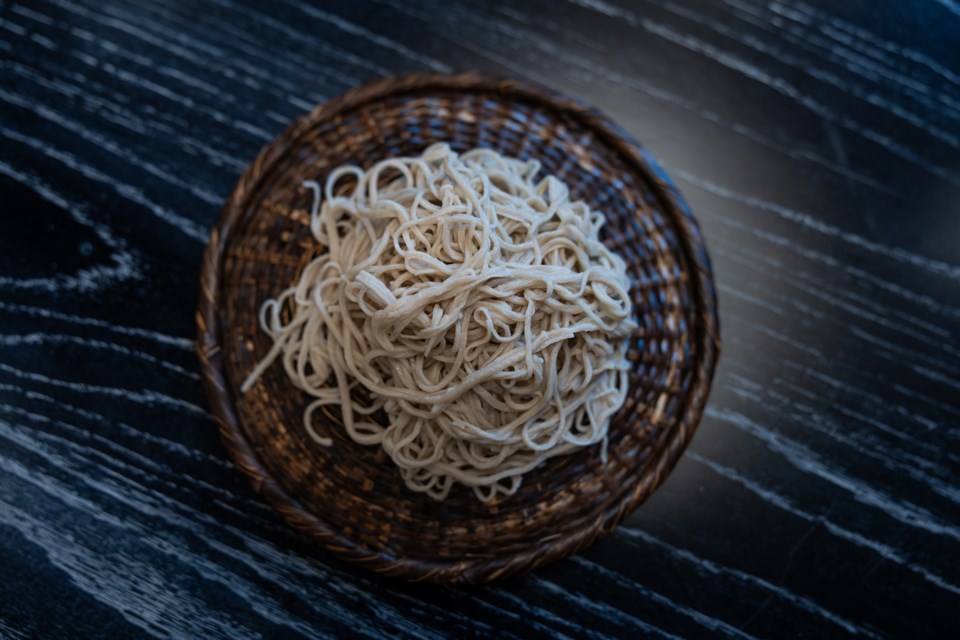Right when you walk in, there’s an old motorcycle. Above, on a small shelf, are several toy models of the Toyota 2000GT, the iconic Japanese sports car. Not exactly what I was expecting to greet me at a traditional soba noodle house.
“I like mechanics,” Teiichi Sakurai tells me. “Because it’s like restaurants.” If one part isn’t working, he explains, the whole thing doesn’t work. “Especially with airplanes,” Sakurai says. “If one part fails, oh my god, what are you going to do?”
We’re in a private dining room at Tei-An, his soba spot in Dallas, sipping tea made from soba noodles. Decked out in a black tee, black athletic pants and white sneakers, the James Beard Award semifinalist is taking a break between lunch and dinner service. Tei-An serves sushi, sashimi and tempura, and its bar is stocked with rare Japanese whiskies, but the handmade soba is what makes the restaurant worth the visit and truly special.
Only a few restaurants outside Japan make their own soba and do it as well as Sakurai. No wonder Toyota execs, celebs and North Texas gourmets head to the Michelin-recommended Tei-An.

“I love soba so much,” he says. Soba is made from buckwheat flour and water, with wheat flour added as a binding agent for the thin noodles. Soba is eaten year-round and served both hot and cold, depending on the season, but since the Edo period (1603-1867), it’s been eaten in Japan on New Year’s Eve, with the long noodles symbolizing a long life. Called toshikoshi soba (crossing-into-the-New Year soba), the dish is deceptively simple, like so many things in Japan, and its savory hot broth is the perfect way to start the year anew — and deliciously.
Making soba isn’t easy. But Sakurai never asked for easy.
1985. Amarillo, Texas. It was night when the plane touched down. Sakurai looked out the window. It was pitch black. He wondered if this was an emergency landing. It wasn’t. “I thought we were in the middle of nowhere.”
Including Sakurai, there were seven exchange students from an aviation school in Yamanashi, Japan. One of those students was Masayuki Otaka, then a fellow flight student, but a future Dallas chef and the owner of the newly-opened Mabo, an intimate and acclaimed yakitori joint. But back then, neither had restaurants on their mind. They were wondering what they had gotten themselves into.
Cowboy hats. Boots. Dusters. “It was such a different culture from Japan,” says Sakurai. That difference was exacerbated by the times. During the 1970s and ’80s, some viewed his home country, a rising economic superpower, as a threat. There were fears that Japan was on its way to overtake America’s economic hegemony. “I didn’t know what the American people felt and how they viewed us,” Sakurai says, “but the people there kept looking for ways to connect.”

One time, Sakurai was at Target. Or maybe, it was Walmart — he doesn’t remember, exactly. “There were these rows of televisions, and a customer came up to me and said, ‘Excuse me. Are you Japanese?’” Yes, he replied. “The customer then said, ‘Can you please explain this TV to me?’” Sakurai replied that he didn’t work there. “But,” he says, “they were always looking for these openings.”
Six months passed. It was fall. “Another student asked if we had plans for Thanksgiving,” says Sakurai. “I didn’t even know what that was.” Sakurai and the other students were invited over for turkey, and any remaining walls began to crumble. The initial hesitation was gone. “Amarillo is such a beautiful town, filled with beautiful people who help each other and check in on each other,” he says. “That wouldn’t happen in Tokyo.”
“We don’t use any machines when making soba.”
“It’s so fragile,” Sakurai says, scooping soba out of a steaming hot bath. The boiling contraption is direct from Japan. “It takes six months for one of these to arrive here,” he says, pointing to the large metal bath. “So I ordered two and keep the backup in storage.”
Soba is delicate. If the ratio of water to flour isn’t right, the noodles fall apart. Things like temperature and humidity impact the soba, so the ratios are tweaked daily based on the weather. And then, there’s the matter of just making it.
“For house-made pasta, you use a machine,” Sakurai says. “We don’t use any machines when making soba.” The dough is rolled out and then cut by hand. “My apprentice has been doing this for a year, and he takes 40 minutes to make one kilo of soba,” Sakurai says. “I can do it in 25.”
Sakurai couldn’t always make soba. Heck, it wasn’t that long ago that you couldn’t even get handmade soba in the United States, let alone in Texas. While in Amarillo, Sakurai saw that the aviation industry was hitting rough times, especially in Japan. With a weak yen and a strong dollar, working in restaurants was more lucrative than heading back home.
After cutting his teeth in a local hibachi eatery in Amarillo called Kabuki, Sakurai moved to Dallas, getting a job as a sushi chef at the now-shuttered Royal Tokyo on Greenville Avenue. Founded in the early ’70s, it was one of the first authentic Japanese restaurants in North Texas. It was also where, as a child in the mid-1980s, I ate Japanese food for the first time, my nascent taste buds savoring the salty, umami goodness of miso soup.

With enough money saved, Sakurai struck out on his own and opened his first restaurant, Teppo, a yakitori (charcoal-grilled chicken skewer) restaurant, on Greenville Avenue in 1995. DFW had seen nothing like it. The restaurant caused a sensation. Three years later, he followed that up with Tei Tei Robata, the first restaurant in Texas to serve hot rock wagyu. The dish is now a staple at Japanese restaurants throughout Collin County and Dallas County. After nearly 30 years, Teppo closed, but Tei Tei continues, now owned by the restaurant’s original executive chef, Katsutoshi Sakamoto, another of Sakurai’s old friends from aviation school in Amarillo.
High-rolling guests flew in on private planes just to eat soba at Tei-An.
As Texans embraced sushi and Japanese food, Sakurai saw an opportunity: soba. First, he loved the dish, and second, he thought he could create a new market, not only challenging himself as a chef but also differentiating himself within the growing Japanese restaurant scene.
No stranger to new beginnings, Sakurai studied at Tsukiji Soba Academy in 2006. It was not easy. “I was already a chef, so I didn’t have to relearn things like knife work,” Sakurai says, “but it was even harder for those who didn’t already come from a culinary background.”

For two years, he worked at perfecting soba, including kuichi soba, with ku (9 in Japanese) and ichi (1) referring to the ratio of 90 percent buckwheat to 10 percent wheat flour, as well as the delicate juwari soba (100 percent buckwheat soba), which can fall apart if not handled gently. Buckwheat is gluten free, and great care is required to make juwari soba because it lacks the sticky glutinous glue to hold the noodles together.
Sakurai returned to Dallas and opened Tei-An in August 2008. Initially, things were slow — real slow. The global financial crisis that followed a month later didn’t make things easier. But thanks to local rave reviews and a New York Times mention, the restaurant became a true destination, with high-rolling guests flying in on private planes just to eat at Tei-An.
Dinner service starts soon. Sakurai goes through his list to make sure everything is ready in the dining area and the prep work is done in the kitchen. No part of the process can break down. Every part of the orchestrated meal must be smooth. Think, pre-flight checks.
The diners tonight are in for a treat. A month earlier, I brought my wife to Tei-An for a surprise dinner. I still can smell the fragrant dashi of the broth and taste the elegant, yet rustic and earthy buckwheat noodles.
“Japanese people know how hard it is to make soba,” he says. But, I ask, do you think people here know how hard it is? Not missing a beat, Sakurai replies, “They do now.”
The Way Of Soba originally appeared in the Jan./Feb. 2025 issue of Local Profile. To subscribe, click here.
Hungry for more? Check out our dining guide. Don't miss anything Local. Sign up for our free newsletter.




